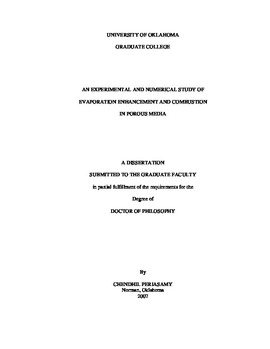| dc.contributor.advisor | Gollahalli, Subramanyam R., | en_US |
| dc.contributor.author | Periasamy, Chendhil. | en_US |
| dc.date.accessioned | 2013-08-16T12:20:40Z | |
| dc.date.available | 2013-08-16T12:20:40Z | |
| dc.date.issued | 2007 | en_US |
| dc.identifier.uri | https://hdl.handle.net/11244/1196 | |
| dc.description.abstract | The results showed that the pressure drop across the porous media increased as the coflow air velocity, temperature, and linear pore density of the medium were increased. The measured and predicted surface temperatures of evaporation and combustion porous media showed that the temperature distribution was uniform within +/- 25 K and 50 K, respectively. The droplet Sauter mean diameter data revealed that the spray core region contained droplets with lower diameter, and the droplet diameter increased radially outward. A heat feedback rate to the evaporation porous medium section of about 1% of the average heat release in the combustion section was needed to completely vaporize the kerosene fuel. The vapor concentration level downstream of evaporation porous medium with 1% combustion heat release feedback was 63% higher than that with no heat feedback. | en_US |
| dc.description.abstract | Our results also suggest that the use of porous media in combustors allows operation at a lower coflow air temperature or with a shorter evaporation section. The porous-medium-burner concepts developed in this dissertation can be employed in many practical liquid combustion systems such as gas turbine combustors, air-heating systems, industrial burners, porous chemical reactors, heat recovery systems, and hybrid burners for bio-fuels. | en_US |
| dc.description.abstract | Stable spray flames were established both inside (referred to as interior flames) and on the downstream exit surface (surface flames) of the combustion porous medium. The equivalence ratio at flame extinction in each mode was determined. The extinction equivalence ratio decreased with a decrease in coflow air velocity. A nominal value of Damkohler number of 5.0 was required to initiate the interior combustion mode. As Damkohler number was increased, the extinction equivalence ratio decreased (i.e., extending the fuel lean operation). The axial temperature profiles in evaporation and combustion porous media were measured. Also measured were the radiative heat release from porous medium downstream exit surface, and pollutant emissions of carbon monoxide and nitric oxide. The results demonstrate the benefits of porous medium in making NO emission somewhat insensitive to operating parameters such as equivalence ratio and location of injector. | en_US |
| dc.description.abstract | Blocks of open-cell, silicon carbide coated, carbon-carbon ceramic foam of bulk cross section 4 x 4 cm and thickness of 2.5 cm were used as porous medium sections for liquid evaporation and subsequent combustion. Liquid fuel (kerosene, n-heptane, and methanol) was sprayed into a co-flowing, preheated (350--490 K) air environment using an air-blast atomizer, and the spray subsequently entered the porous medium. In controlled evaporation studies, combustion heat feedback to evaporation porous medium was simulated with a resistive heating mechanism. The minimum heat feedback rate required for complete vaporization of liquid and the vapor concentration profiles downstream of evaporation porous medium were measured. The stable operating regimes of spray flames in the combustion porous medium were determined and a general understanding of flame extinction in porous media was developed using a Damkohler number analysis. | en_US |
| dc.description.abstract | A two-energy equation model was developed to study the evaporation enhancement of liquid spray in the porous media. Combustion in the porous media was simulated by using a uniform volumetric heat source in the porous region. The solid and gas phase equations were coupled using a volumetric heat transfer coefficient. The computer simulations were performed with a commercial code, Fluent(TM) 6.0. | en_US |
| dc.description.abstract | Combustion of gaseous fuels in porous media improves combustion performance and reduces pollutant emissions by transferring combustion heat upstream via conduction and radiation to preheat reactants. Such heat feedback may be beneficially exploited to enhance vaporization of a liquid sprayed upstream of the porous medium, in addition to improving combustion performance. This dissertation presents an experimental and computational study of evaporation enhancement and combustion of liquid spray aided by porous media. | en_US |
| dc.format.extent | xxii, 300 leaves : | en_US |
| dc.subject | Porous materials. | en_US |
| dc.subject | Heat of combustion. | en_US |
| dc.subject | Evaporation. | en_US |
| dc.subject | Engineering, Mechanical. | en_US |
| dc.title | An experimental and numerical study of evaporation enhancement and combustion in porous media. | en_US |
| dc.type | Thesis | en_US |
| dc.thesis.degree | Ph.D. | en_US |
| dc.thesis.degreeDiscipline | School of Aerospace and Mechanical Engineering | en_US |
| dc.note | Source: Dissertation Abstracts International, Volume: 68-04, Section: B, page: 2611. | en_US |
| dc.note | Adviser: Subramanyam R. Gollahalli. | en_US |
| ou.identifier | (UMI)AAI3261119 | en_US |
| ou.group | College of Engineering::School of Aerospace and Mechanical Engineering | |
